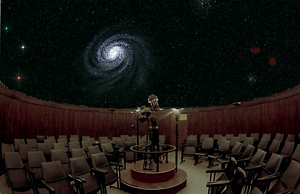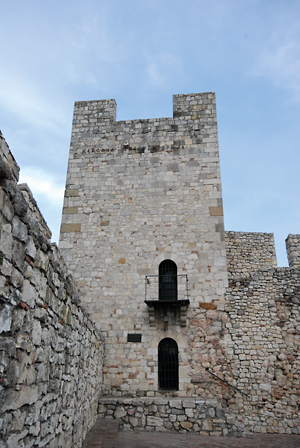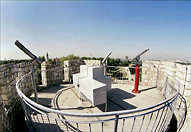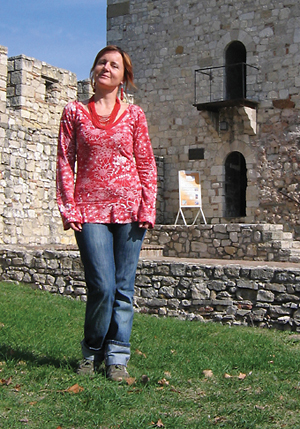Sky
PLANETARIUM ON KALEMEGDAN: THE SPACE THEATRE IN THE OLD FORTRESS
The Secret Life of Cosmic Towns
The Academic Astronomy Association in Belgrade was established seventy five years ago, and the planetarium was bought forty two years ago (from the German company ”Carl Zeiss” from Jena). Since then, in Kalemegdan’s Upper Town generations went on never-ending sky trips. If plans and dreams of those who care about it today come true, the Belgrade Planetarium could be as famous as the ones in Valencia and Athens
By: Slađana Ristić
 In Upper Town of Kalemegdan there is a place where people can know everything about stars, to touch them for a moment and to listen to the sound of faraway cosmic towns. It is visited by space lovers, travellers, young researchers, artists. The Planetarium, the house of stars, is owned by the Astronomy Association ”Ruđer Bošković”. We can also call it a school and a theatre and a cinema, but the projection is not on flat screen, like in the movies, but on a hemisphere screen. Planetarium is making an impression of a sky covered with stars above our heads. We don’t have to wait 24 hours for the sky to rotate (as it happens in real world), but we can rotate it ourselves and see the sky above the North Pole or the equator, or we can also travel from the North Pole to the equator in just a few minutes. In Upper Town of Kalemegdan there is a place where people can know everything about stars, to touch them for a moment and to listen to the sound of faraway cosmic towns. It is visited by space lovers, travellers, young researchers, artists. The Planetarium, the house of stars, is owned by the Astronomy Association ”Ruđer Bošković”. We can also call it a school and a theatre and a cinema, but the projection is not on flat screen, like in the movies, but on a hemisphere screen. Planetarium is making an impression of a sky covered with stars above our heads. We don’t have to wait 24 hours for the sky to rotate (as it happens in real world), but we can rotate it ourselves and see the sky above the North Pole or the equator, or we can also travel from the North Pole to the equator in just a few minutes.
The visitors of this planetary oasis can travel through time, into the past and into the future, seeing the constellations in one hundred years, in one thousand years (which changes very slowly in astronomy). In the middle of the hall, in the space of a former Turkish steam bath, there is an optical-mechanical-electronic system of projectors that is also called the planetarium and seats are all around it. Besides the official projector, there are many others, which project planets, comets, artificial satellites, sides of the world. We can additionally use different projectors (sliders, video projectors).
 Getting to know the world of cosmos is the main motive why people come to the Belgrade Planetarium. For them it is a unique and unforgettable visual enjoyment: the sky rotates above their heads and the stars are shining, as well as the story we tell them. The visitors do not study stars, but they make part of a magnificent and modern theatre and circus, which takes them to faraway voyages. Some of them asked us: ”Are there aliens!?” – says Nataša Stanić, the Manager of the Belgrade Planetarium. Getting to know the world of cosmos is the main motive why people come to the Belgrade Planetarium. For them it is a unique and unforgettable visual enjoyment: the sky rotates above their heads and the stars are shining, as well as the story we tell them. The visitors do not study stars, but they make part of a magnificent and modern theatre and circus, which takes them to faraway voyages. Some of them asked us: ”Are there aliens!?” – says Nataša Stanić, the Manager of the Belgrade Planetarium.
The planetarium was bought in 1966, on the initiative of the former President of Yugoslavia, Tito. On one of the fairs of technical equipment, he saw the promotion of the German company ”Carl Zeiss”, which was the first in the world to develop projectors that can make an artificial sky full of stars. At that time, it was a hit. The company exhibited its Planetarium, on the Fair, in a specially made dome. That is when the representatives of the Astronomy Association ”Ruđer Bošković” succeeded in convincing Tito that the machine is very important for them. Tito supported the idea of buying the planetarium.
Some time later, it was decided that the money is invested in the adaptation of the Turkish steam bath on Kalemegdan (below Church Ružica) and that the planetarium is place there. The Parliament of Belgrade provided the means for the adaptation, the purchase of 80 seats and other furniture. There were many problems during the making of the plan for the adaptation and the arrangements lasted for four years. The opening of the Planetarium was on February 27th 1970. A few years before that, in 1964 (December 20th), the National Observatory was moved into the adapted Despot’s Tower in Kalemegdan, just before the opening of the Planetarium.
CONSTELLATION LOVERS  The Association ”Ruđer Bošković” is one of the oldest astronomy associations in the Balkans. It exists for 75 years now. The initiators and the authors of the first Academic Astronomy Association were Đorđe M. Nikolić, Pavle Emanuel and Frano Simović. The University senate approved the programme of the Association on December 22nd 1933. The founders’ assembly took place on April 22nd 1934. Students of astronomy established the Belgrade Astronomy Club ”Ruđer Bošković” in 1951. As the time passed, more and more amateurs and citizens entered the Club and in 1953 it was called the Astronomy Association ”Ruđer Bošković”. The founders of the new Association were Doctor Radovan Danić, surgeon and astronomer, Pero Đuković, science collaborator of the Astronomic observatory, Aleksandar Kubičela, astronomy student, Doctor Đorđe Nikolić, the Chief of the Astronomy department of the Geographic Institute JNA, Josip Slavenski, composer and professor of the Music Academy, astronomy students Jovan Simovljević, Đorđe Teleki, Milorad Topalov, Milenko Nikolić. The Association ”Ruđer Bošković” is one of the oldest astronomy associations in the Balkans. It exists for 75 years now. The initiators and the authors of the first Academic Astronomy Association were Đorđe M. Nikolić, Pavle Emanuel and Frano Simović. The University senate approved the programme of the Association on December 22nd 1933. The founders’ assembly took place on April 22nd 1934. Students of astronomy established the Belgrade Astronomy Club ”Ruđer Bošković” in 1951. As the time passed, more and more amateurs and citizens entered the Club and in 1953 it was called the Astronomy Association ”Ruđer Bošković”. The founders of the new Association were Doctor Radovan Danić, surgeon and astronomer, Pero Đuković, science collaborator of the Astronomic observatory, Aleksandar Kubičela, astronomy student, Doctor Đorđe Nikolić, the Chief of the Astronomy department of the Geographic Institute JNA, Josip Slavenski, composer and professor of the Music Academy, astronomy students Jovan Simovljević, Đorđe Teleki, Milorad Topalov, Milenko Nikolić.
When one of these enthusiasts finds himself on the terrace of despot’s Tower, he thinks of the great astronomers, as the Danish Tiho Brahe, who had the most precise catalogue of looking at the stars, or Galileo Galilei, who was the first to use the telescope in 1609. On that magic place, they think about the writer Edgar Allan Poe and the German astronomer Johann Mädler but about other artists as well, who examined the sky, every one of them in his own way. Laza Kostić and Vladislav Petković Dis were also into stars and they were looking for a connection between their muses and the stars. The Master in Astronomy and the manager of the planetarium, Nataša Stanić, published a book called Cosmic Towns.
 People live in regular towns and stars live in cosmic towns, because there is also birth, life and death, among the stars. The life cycle is present in all cosmic dimensions. Cosmic towns are the shining soul of space – says Nataša Stanić. People live in regular towns and stars live in cosmic towns, because there is also birth, life and death, among the stars. The life cycle is present in all cosmic dimensions. Cosmic towns are the shining soul of space – says Nataša Stanić.
Today, in Kalemegdan one can meet many famous writers studying the sky and walking to Church Ružica. You could once see the Nobel Prize Winner Ivo Andrić. In the last few years, the astronomers have opened the door of the Planetarium to all artists who wish to show their work under the stars (book promotions and performances were organized).
PROTECTING THE DARK Most of the people come to see the stars in the summertime, when it is hot, but the best sky visibility is during the winter. In the time when the National Observatory was established, more stars could be seen above Belgrade, meaning that every sort of pollution is more serious and that it increased for a few decades. According to some estimates, for two or three decades we may not be able to see the sky from the town centre. There is a great campaign going on in the world for preserving the dark sky as the most important world cultural heritage. In the middle of the 70s of the 20th century, in the International Astronomy Union, the Board for the protection of the dark was established.
The United Nations proclaimed 2007, 2008 and 2009 for the international years of planet Earth, wanting to pay the people’s attention on exciting and amazing knowledge achieved in science while studying our planet. The goal is to show the people how science is important in order to make the planet a safer place and a better place for the future generations. Nataša Stanić and her colleagues are preparing themselves for the International Year of Astornomy, 2009. The Manager of the Belgrade Planetarium will be the main coordinator of the activities for Serbia. As the member of the international Astronomic Union, Serbia is among the first 50 countries starting their preparations.
On Tuesday, Wednesday and Thursday the observatory and the Planetarium on Kalemegdan are open for visitors from 9 am to 5 pm, on Friday and Saturday from 2 pm to 10 pm. One can visit these houses, look at the sky, and talk to the people of science and astronomers-amateurs.
 It would be great if someone would help us in educating young people, perhaps the Town parliament. This object is not only a tourist object but educational as well. According to unofficial questionnaires, the most beautiful view for the tourists is the one from the Kalemegdan Fortress, from the terrace of the National Observatory. The most beautiful planetarium in the world is in the Spanish town of Valencia. It is a small town of science, colored in futurism. It is visited by many tourists from all over the world. The planetarium in Athens is the second popular place in Greece, right after Acropolis. If the Belgrade Planetarium would be modernized (projections, light effects of three-dimensional cosmic experiences), with the help of the town or responsible institutions, it would be the first planetarium in southeast Europe of that kind – says Nataša Stanić. It would be great if someone would help us in educating young people, perhaps the Town parliament. This object is not only a tourist object but educational as well. According to unofficial questionnaires, the most beautiful view for the tourists is the one from the Kalemegdan Fortress, from the terrace of the National Observatory. The most beautiful planetarium in the world is in the Spanish town of Valencia. It is a small town of science, colored in futurism. It is visited by many tourists from all over the world. The planetarium in Athens is the second popular place in Greece, right after Acropolis. If the Belgrade Planetarium would be modernized (projections, light effects of three-dimensional cosmic experiences), with the help of the town or responsible institutions, it would be the first planetarium in southeast Europe of that kind – says Nataša Stanić.
Besides our collocutor, the Planetarium has a large team of experts in astronomy. Aleksandar Otašević is a teacher in the Planetarium and the manager of the Summer School of Astronomy and the Seminar for teachers and tutors. Goran Pavičić is a teacher, in charge of work with talented astronomy students who are preparing for international astronomy Olympiads. Branko Simonović is the collaborator of the National Observatory, observer and working on the popularization of astronomy (working as a demonstrator on a telescope). There are other collaborators: Srđan Đukić, Ana Zlatanović, Dušan Vučković, Nenad Filipović, Nenad Trajković, and others.
Our astronomers deal with great researches. Some of the real star detectives are employed in the Astronomic Observatory on Zvezdara of the Department of Astronomy on the Faculty of Mathematics. In a few scientific astronomic projects, they explore extra solar planets, the Sun, active galactic cores, radio signals from space or the star evolution and star atmospheres, asteroids, binary stars.
Going to the Belgrade Planetarium and the National Observatory is an exciting trip for which we do not need a passport. In the last few years, there are more and more visitors. Some of them wanted to drink Champagne on the terrace of Despot’s Tower and make a toast to the sky. We joined them, of course.
***
Activities
There are telescopes on the terrace of Despot’s Tower. Every Friday and Saturday evening, (when the Sun goes down and the sky is clear) all citizens and guest of Belgrade can see the sky through the telescope. Every Saturday (except November 1st and March 1st), when the dusk comes, star lovers can get to know the elements of astronomy in the Planetarium. In the first half of August, there is a Summer school of astronomy. In the end of August and in the beginning of September Summer Astronomy Meetings are being held, and all interested people are free to come. In the beginning of September, there is a free course ”Astronomy for beginners”.
***
Proportions
The Sun is one of the 200 billion stars in our galaxy, and our galaxy is one of the 100 billion galaxies in space. Five planets can be seen with the naked eye (Mercury, Venus, Mars, Jupiter, Saturn).
***
Result
A team of seven members of young astronomy lovers from Serbia (student from the Mathematics High School and elementary school pupils) won the International Astronomy Olympiad in Ukraine in 2007, on the Black Sea, and won two golden, two silver, three bronze medals and the 1st prize in team championship. The Astronomy Association ”Ruđer Bošković” was introduced in the Book Fair in Belgrade and got praised, also in 2007. |
